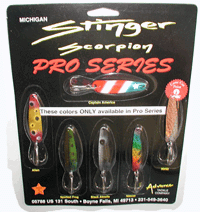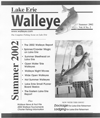Harvest quotas for the 2003 Lake Erie walleye and yellow
perch fisheries have been set by the Lake Erie
Committee of the Great Lakes Fishery Commission and will
remain largely unchanged from the previous year, according to the Ohio
Department of Natural Resources (ODNR) Division of Wildlife.
This year, the entire lake's annual harvest quota of
walleye is again set at 3.4 million fish, while the yellow perch quota is up
slightly to 9.9 million pounds.
The Lake Erie Committee is made up of fisheries managers
representing Ohio, Michigan, Pennsylvania, New York and Ontario. Each year
this committee sets the Total Allowable Catch (T AC), which reflects the
number of fish that can be taken from the lake without harming these
populations.
"By pooling our resources to monitor and manage this
great fishery, we’re cooperatively working to attain healthy fish
populations and an equitable distribution of fisheries benefits among our
member agencies," said Roger Knight, ODNR’S Lake Erie Committee
representative.
"Two years ago, we committed as a group to lowering the
walleye quota to allow this species at least three years to rebuild its
population," said Gary Isbell, fish management and research administrator
for ODNR's Division of Wildlife. Isbell noted that since 2001, the walleye T
AC has remained at 3.4 million fish.
Each state is allotted a share of the total allowable
catch, determined by a formula based on surface area within each
jurisdiction. Ohio and Ontario receive the highest quotas because their
waters encompass the highest percentage of the lake. Of the 2003 quota,
Ohio’s share is just over 1.7 million, about 51 percent of the total.
Ontario’s share is just under 1.5 million walleye, about 43 percent of the
total allocation. The remainder is shared by New York, Michigan, and
Pennsylvania.
Ohio's daily bag limit for walleye caught in Lake Erie
and its tributaries will not change. Anglers may harvest four fish from
March 1 through April 30, and six fish from May 1 through the last day in
February per angler.
Sport fishing on Lake Erie is a catalyst that draws
anglers from all across the nation and helps boost local economies all along
the lakeshore.
"Last year, walleye fishing got off to a slow start
because of the cold and rainy spring weather, but anglers saw improvement as
the summer progressed," said Isbell. "We anticipate anglers experiencing a
better season this year, with good numbers of 19 to 22-inch walleye from the
1999 hatch, many 13 to 15 inch fish from the 2001 hatch, and some 24 to
27-inch fish from the 1996 hatch," he added.
This three-year conservation effort for walleye follows
the similar successful action taken by the Lake Erie Committee to boost the
population of yellow perch. The perch population is improved to the point
the Lake Erie Committee slightly increased the 2003 total allowable catch
for yellow perch to 9.906 million pounds, up from 9.333 million pounds in
2002.
Yellow perch quotas for individual jurisdictions
surrounding the lake are based on a different sharing formula than walleye,
involving surface area and past fishing performance. Ohio's share of the
2003 perch allocation is 4.3 million pounds - about two hundred thousand
pounds above last year - and is allocated between sport and commercial
fisheries.
"The sport fishing catch for yellow perch was tremendous
last year and we anticipate it continuing," said Isbell. "Last year we saw a
lot of 30-fish limit catches, and better angler success than in previous
years. We should see a repeat of that success again this year."
Ontario will receive about five million pounds and
Michigan, Pennsylvania and New York will share the remainder.
Ohio's daily bag limit for sport anglers remains at 30
perch per angler. Existing commercial fishery regulations also remain in
effect
The Lake Erie Committee remains concerned about changes
in the Lake Erie environment caused by aquatic nuisance species and climate
driven impacts on lake levels. Spring weather patterns adversely affected
walleye and yellow perch hatches in 2000 and 2002 and the committee
anticipates major cuts in walleye and perch TAC in 2004 and 2005 to help
offset these poor hatches. Work by the member agencies will continue through
the summer to determine strategies for reducing harvest where necessary and
for protecting Lake Erie's valuable resources.
For additional news online, check out the ODNR Press Room at:
http://www.dnr.state.oh.us/communications/default.htm
.




